Archive
Organic semigroup theory: ferns growing in the Jones/Temperley-Lieb monoid
What is the interesting part of doing science? When a new idea, or some new technology enable us to see some unexpected connection between seemingly unrelated areas. As the new technology, take the bipartition capabilities of the Semigroups package for GAP, and the related visualisation tools. For the seemingly unrelated fields, take semigroup theory and fractal geometry. Here is the story.
The Jones/Temperley-Lieb monoids are interesting combinatorial representations of semigroups. For degree 4 here are the usual generators:
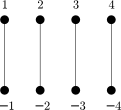 ,
, 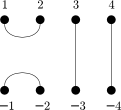 ,
, 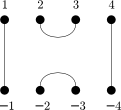 ,
,  .
.
Only pairs of dots are connected, and the diagram is planar as a graph. The multiplication is the usual diagram composition, stacking two diagrams, connecting the dots, and doing the simplification if possible. Unlike in diagram algebras, the `bubbles’ in the middle are simply discarded.
Here is a random element of , exhibiting some typical features.
I said `interesting’ before, so I owe you the justification. In mathematics interesting is often equal to difficult. There are a few open questions regarding the combinatorics of the Jones monoid. For instance, one of the basic questions for semigroups is the number of idempotents. By sheer silicon power and coding finesse we can figure out some low degree values (A225798) but we have no formula for that, so beyond our computational horizon it is just darkness.
In semigroups, when you are looking for idempotents, you simply look at the -class picture, and find the
-classes with idempotents. Assuming that you have the luxury of having the
-class picture in sight. Luckily GAP + Semigroups + VIZ give you exactly that. So Eastie did so. Ok, we still don’t have the closed formula (it probably requires a bit more work than just looking), but he discovered this:
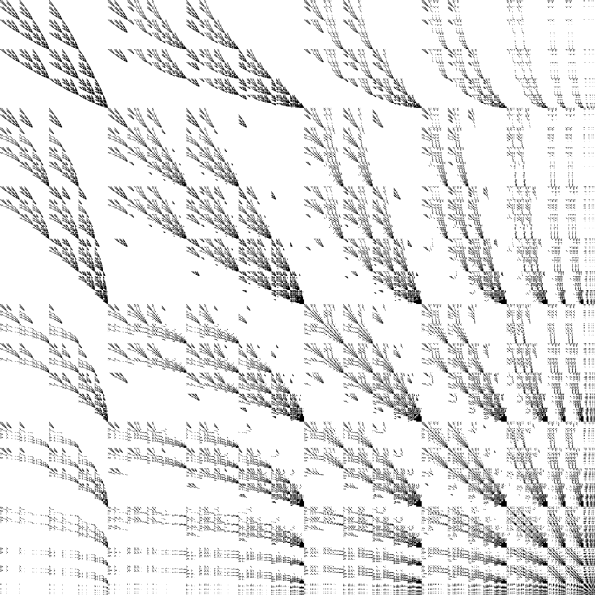 This is a diagram showing the locations of the idempotents in a
This is a diagram showing the locations of the idempotents in a -class of
. Yes, they look like ferns, or more like iterated attempts to get the shape of the fern right ( in the top left corner). And it really looks like those images generated by iterated function systems (repeated affine transformations of a simple geometric object), for example the Barnsley fern.
This image is of course not the first one we saw, by
gap> Splash(DotDClasses(JonesMonoid(9)));
you get something like this:
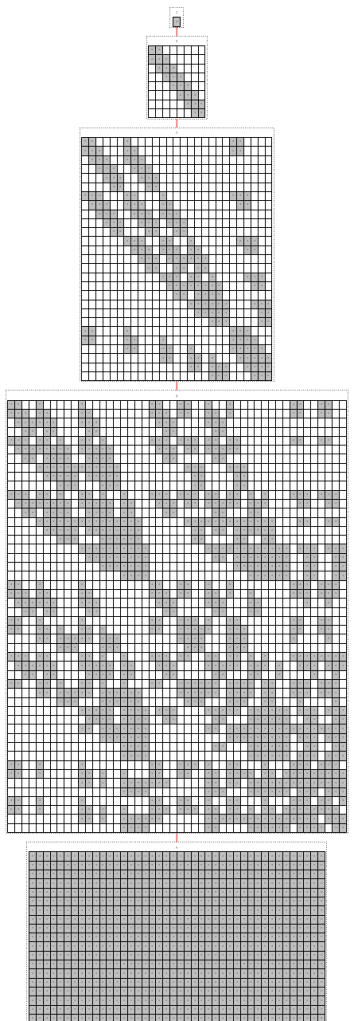 but when you increase the degree, the generated images eventually choke your PDF-viewer. Also, we wanted to see the images in high-definition, pixel per idempotent precision, so a little bit of extra coding was needed. The situation is reminiscent of Mandelbrot’s discovery of the Mandlebrot set. The first images were very crude, so they had to sharpen the tools to see them more clearly. Except that in his case he was searching for the set, while for the Jones monoid, James was on his routine patrol.
but when you increase the degree, the generated images eventually choke your PDF-viewer. Also, we wanted to see the images in high-definition, pixel per idempotent precision, so a little bit of extra coding was needed. The situation is reminiscent of Mandelbrot’s discovery of the Mandlebrot set. The first images were very crude, so they had to sharpen the tools to see them more clearly. Except that in his case he was searching for the set, while for the Jones monoid, James was on his routine patrol.
Needless to say that the image depends on the ordering of the – and
-classes, but the algorithm happens to do the right, systematic ordering. Otherwise, the discovery would have been delayed, until someone comes shrewd (or desperate) enough to try reordering.
For the time being, we have no explanation of the ferns growing inside the semigroup structure of the Jones monoid. Knowing that this structure is of interest for physicists, we are wondering about the possible biological connections. In any case, so far we’ve been simply interested in the Jones monoid, but now we are interested and EXCITED! 🙂
